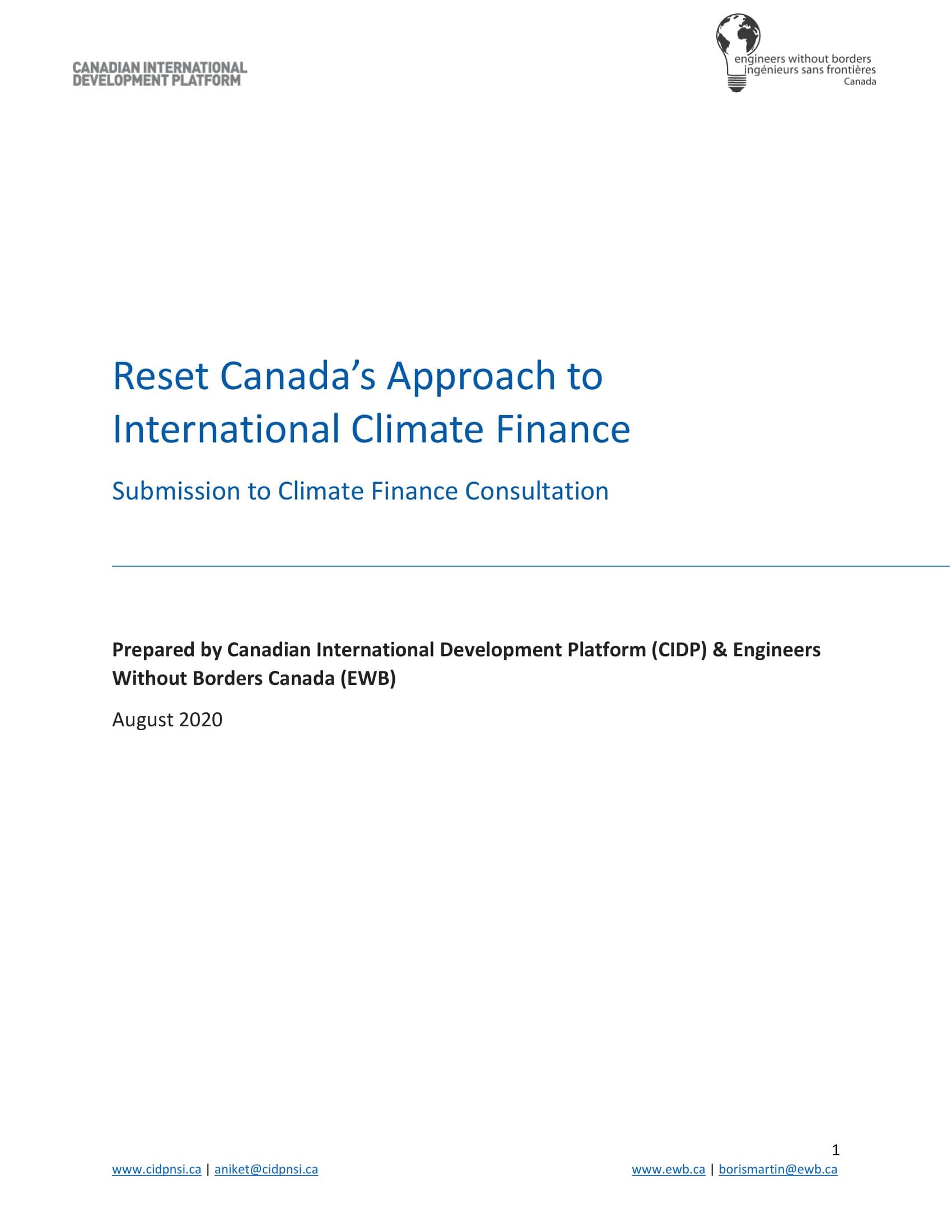
Reset Canada’s Approach to
International Climate Finance
Published: August 2020
This report presents Canadian International Development Platform and Engineers Without Borders Canada submission to Global Affairs Canada’s international climate finance consultations:
Canada’s approach to international climate finance (ICF) requires nothing short of a hard reset.
Since the PM announced the CAD$2.65bn (2015-20) ‘ICF 1.0’ commitment in the lead up to COP21 – celebrated misleadingly as a “doubling” of Canada’s contribution – it is impossible to conclude Canada’s approach has been driven by anything other than bureaucratic efficacy or the need to ‘get money out the door quickly’. ‘ICF 2.0’ needs to do better at a foundational level.
Key Messages
Rethink Canada’s ICF contributions from the ground up
- The level, type, and structure of financial support provided by Canada is out of step with its global rhetoric.
- Increases in ICF – such as “doubling” – must be met by commensurate increases in the overall envelope (IAE). Otherwise they result in “robbing Peter to pay Paul”, which is precisely the case with the ICF 1.0 commitment.
- It is problematic when scarce IAE dollars, best used to support grant-based aid, are used to fund on-lending, and, become unduly exposed to vagaries (e.g. currency risk) beyond programmatic control. This was also the case with ICF 1.0.
- Canada is an outlier among climate donors. The type of support it provides (grants vs. loans) and how the support is provided (bilateral vs. multilateral channels) is highly imbalanced.
- 80% of Canada’s principal level ICF contributions are debt-instruments intermediated exclusively via multilateral trust funds (e.g. at ADB, IDB, IFC).
- ICF 1.0 has used a significant amount of scarce IAE resources to pay multilaterals non-transparent and not insignificant fees to subsidize their on-lending. With little evidence of developmental or financial leverage. This is highly problematic.
- Better results can be achieved at lower cost working directly with climate fund managers, local partners, and Canadian institutions with relevant expertise.
Respond to the lack of coherence between Canada’s ICF and the FIAP’s gender targets
- Pressures to demonstrate too many inconsistent results out of the same limited quantum of investment leads to a program that fails to clearly define objectives and prioritize meaningful outcomes.
- This is clearly visible in the lack of coherence and limited overlap between climate and gender in Canadian programming.
- Gender principal investments account for less than 2% of Canada’s climate finance.
- Gender and feminist approaches are hugely important but combining “climate washing” with “gender washing” serves neither and fails both.
- ICF 2.0 needs to examine the limited practical overlap between climate and gender honestly and critically.
- To pursue gender objectives ICF 2.0 needs to allocate a greater level of bilateral grant funding that can be directed to niche partners.
Define Canada’s approach to risk and parameters of private sector engagement (PSE)
- Canada’s risk tolerance and approach to risk remains ill-defined. This stems from the input side (Finance, Treasury Board, ultimately PMO), but the weakest link in the chain is GAC’s ill-considered and seemingly highly risk averse approach.
- GAC is limited by its lack of internal capacity to manage investments and a myopic perspective on risk-return. The department is unprepared or simply unable to work with the private sector and lacks understanding of leveraging private capital.
- Clear evidence is the fact that the much-hyped CAD$1.5bn IAIP announced as a doubling of innovative finance in Budget 2018, has to date failed to approve a single project. The program has been merged into climate finance and is being “rebooted”.
- GAC’s approach to risk and PSE are alarming even by its own low standards and demand a serious review. Other government departments which have much greater climate science and PSE expertise (e.g. Environment ECCC; Natural Resources NRCan; Industry ISED) should be empowered to play a much bigger role in ICF 2.0.
- Canada’s approach to debt-based climate finance is unusual and unlike any other major donor.
- Unlike Canada, major debt providers (Japan, Germany, France, Korea), provide financing directly to developing country governments and or public and private institutions. Canada intermediates debt support exclusively via multilaterals.
- The ticket sizes of Canadian supported investments are a fraction of investments undertaken by other donors. Attribution of impact (and risk) is clear and direct for other donors, it is anything but for Canada.
- Canada has created several “branded” trust-funds at multilateral banks. However, Canada does not call the shots on investments. It outsources key decisions to multilaterals. Canada branded funds create confusion in the market with FinDev Canada and could lead to situations where one competes and undermines the other’s business, all under the same flag.
- Despite GAC’s ‘blended finance’ rhetoric, we find no evidence of private capital mobilization. In fact, the track-record of multilaterals is particularly poor (and worsening) on this front by their own admission. For a $1 in climate finance Canada’s preferred multilateral partners mobilize far less than a $1 in private capital.
- Worse still, Canadian funds may be distorting the market by de-risking multilaterals too cheaply and pricing private investors out of the market.
- The main reason this happens is GAC/GoC’s ill-defined and ill-considered approach to risk, which views any investment channeled via multilaterals as low risk.
- If GAC/GoC are serious about attracting private capital and catalyzing real climate impact, ICF 2.0 should price inputs higher, take appropriate risk, offer to make equity investments (which are more catalytic), and work with mid-market firms and climate funds directly.
Questions or Comments?
Please email: info@cidpnsi.ca.


Recent Comments